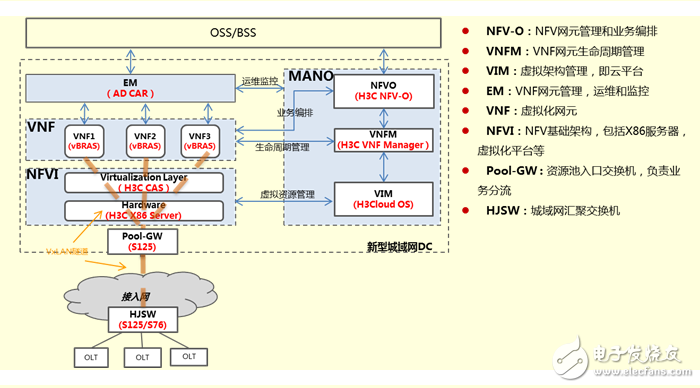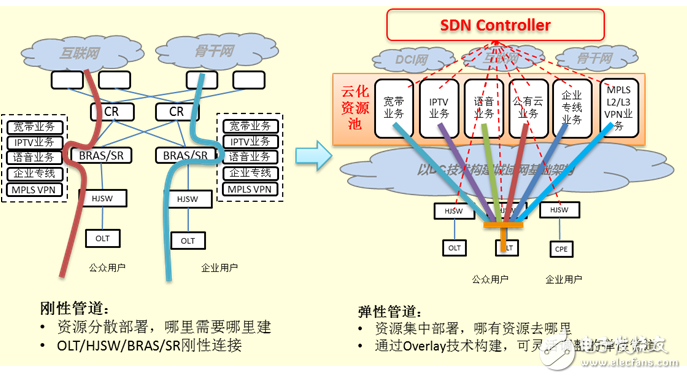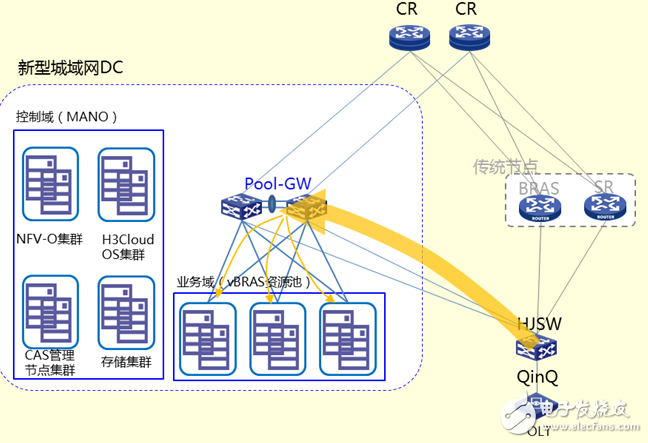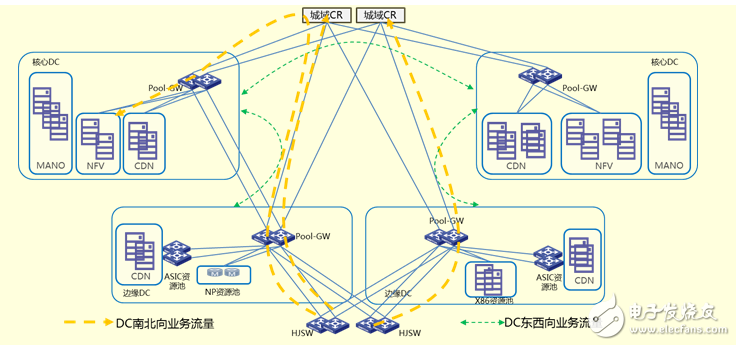Tractor Autopilot Navigation,Gps Navigation System,Gps Autopilot,Unmanned Driving System Xuzhou Jitian Intelligent Equipment Co. Ltd , https://www.jitianintelligent.com
Xinhua III launches vBRAS resource pool solution and practical application
The Broadband Remote Access Server (BRAS) is a critical component located at the network service provider's Point of Presence (POP) within the operator's domain network. It serves as the entry point for users to access various services. As the first gateway that users encounter when connecting to the network, the BRAS manages a vast amount of user-related data, including IP addresses, PPPoE/IPoE sessions, Quality of Service (QoS), and Access Control List (ACL) attributes. These configurations are essential for ensuring both security and service quality. Given its pivotal role in the metropolitan area network, the importance of the BRAS cannot be overstated.
Carrier network reconfiguration has become one of the most prominent topics in the telecommunications industry in recent years. A key part of this transformation is CORD, which stands for Central Office Re-architected as a Datacenter. In simple terms, CORD represents the shift from traditional network rooms to data centers. Specifically, R-CORD refers to the data center transformation of the metropolitan area network, especially for domestic operators.
The metropolitan area network is a crucial part of an operator’s infrastructure and a major revenue source. However, with the rapid growth of "Internet+" and the challenges posed by over-the-top (OTT) services, operators have faced numerous issues. To address these challenges, they are striving to build an open, flexible new metropolitan area network through R-CORD, aiming to reduce costs, increase revenue, and enhance competitiveness.
The operating mall domain network consists of several systems, such as the transmission bearer system, service control system, and OSS/BSS systems. Each of these systems typically relies on proprietary hardware and private interfaces, making the network closed and difficult to manage. The dedicated hardware is not versatile, expensive, and often locked into specific vendors. Additionally, the distribution of network equipment leads to uneven loads, resulting in low utilization rates and higher construction costs. Operators are seeking solutions through network reconfiguration, specifically via R-CORD, to overcome these challenges.
**1. Applying SDN, NFV, and Cloud Computing Technologies to the Metropolitan Area Network**
SDN, NFV, and cloud computing are widely used and successful technologies in the internet industry. While the operator’s metropolitan area network differs significantly from the internet industry’s network, the application of these technologies in R-CORD has unique characteristics.
**1. DC Reconstruction of the Metropolitan Area Network**
Traditionally, the business systems in the metropolitan area network operate independently, using dedicated hardware and private interfaces. This results in isolated systems, leading to the formation of “business silos.†Network construction is often based on administrative divisions, with scattered computer rooms that prevent cross-room service deployment. The goal of DCization is to centralize resources, create resource pools using cloud computing, break down silos, enable resource sharing, and improve utilization while reducing costs.
**2. NFV**
NFV transforms dedicated hardware into virtual network functions, deploying them on general-purpose X86 servers. Through NFV, operators can reduce dependency on proprietary hardware, achieve more generalized infrastructure, and lower costs. NFV network elements offer flexibility, supporting functions like vBRAS, vLNS, vFW, vLB, and vCPE. New services can be launched quickly by creating or upgrading NFV elements without changing the underlying server, enabling fast deployment and service activation.
**3. SDN**
SDN includes various aspects, such as Overlay technology. By using VXLAN tunnels, it enables the creation of large Layer 2 networks, overcoming physical location constraints between resource users and owners. This shifts the approach from “where the resources are†to “where the needs are,†revolutionizing resource scheduling and management.

**Second, the Design of the New Metropolitan Area Network vBRAS Resource Pool Solution**
The new metropolitan area network vBRAS resource pool solution leverages SDN, NFV, and cloud computing technologies. It follows the ETSI NFV standard architecture, incorporating components like NFV-O, VNFM, VIM, NFVI, VNF, and EM.

This solution integrates multiple vBRAS network elements into a resource pool, deployed on the NFVI infrastructure and managed through MANO. The access network aggregation switch routes user traffic to the front-end switch Pool-GW of the new metropolitan area network (DC) via VXLAN tunneling, then offloads the traffic to the appropriate vBRAS element in the resource pool. The Pool-GW acts as the entrance to the resource pool, masking internal changes and simplifying access network management while enabling true resource pooling.
The vBRAS resource pool solution is a complete R-CORD implementation and is also an open solution. It supports interoperability between different manufacturers, promoting decoupling of VIM, NFVI, and virtualization platforms. Xinhua III actively participates in decoupling tests and pilot projects, having completed interoperability testing under the ETSI NFV standard architecture with China Telecom Beijing Research Institute in 2016.
**Third, the Practical Application of the New Metropolitan Area Network vBRAS Resource Pool Solution in the Operation of the Mall Domain Network**

Figure 3 shows a typical network setup for the new metropolitan area network, deployed in Jiangsu Telecom, Jiangxi Telecom, and Shandong Unicom. The control and service domains are located in the DC. To ensure reliability, the control domain's management components are clustered. The vBRAS resource pool is connected under the Pool-GW, which serves as the unified entry and exit point for the resource pool. Remote aggregation switches access the Pool-GW via VXLAN tunnels, and the Pool-GW distributes the VLANs to each vBRAS element for processing.
In practice, some local offices still use traditional BRAS/SR equipment for legacy broadband services, but they route high-volume, low-traffic services to the vBRAS resource pool. This allows operators to start with profitable services, protect existing investments, and gradually transition to full network reconstruction. Some sites fully utilize the vBRAS resource pool for all services.
The new metropolitan area network solution continues to evolve alongside operator network reconfiguration. Before 2016, it was primarily focused on single vBRAS function verification and small-scale pilots. In 2016, the vBRAS resource pool was deployed and scaled to support more users. By 2017, investment began in multi-level DC construction to meet the needs of city-wide network reconstruction.

Figure 4 illustrates a multi-level DC setup for a city’s metropolitan area network. Based on H3C’s new metropolitan area network solution, a two-tier DC structure is implemented, consisting of core DCs and edge DCs. Core DCs handle centralized services like ITMS/RMS and VOIP, while edge DCs manage delay-sensitive services such as broadband Internet and IPTV. A DC link connects the two core DCs, allowing mutual backup and global service scheduling. Each aggregation switch connects to two edge DCs, ensuring quick failover in case of a failure.
**Conclusion**
R-CORD for carrier network reconfiguration is a long-term and complex process, yet it is essential for operators. Through commercial deployments across multiple cities and operators, the new metropolitan area network solution has achieved large-scale service delivery, enabling operators to experience real cost and technical advantages. As the requirements of the carrier network and services evolve, the new metropolitan area network solution will continue to develop and improve, better supporting the ongoing efforts of network reconfiguration.